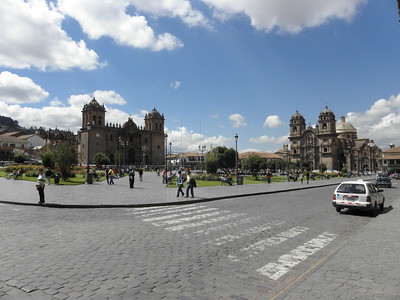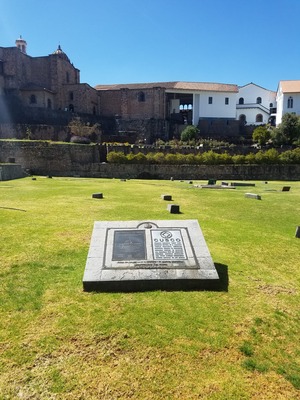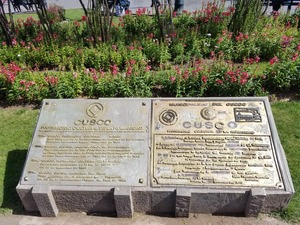Cuzco

The City of Cuzco combines the cultures of the Inca capital and the Hispanic colony.
The Incas developed the city in the late 15th century for their imperial government that ruled over much of the Andes. They aimed to create an ideal town, with administrative and religious functions in the center and agriculture and industrial production in the outlying areas. The first Spaniards arrived in the city in 1533. They constructed their own buildings (catholic churches, mansions) on the demolished walls of the Inca buildings, but left the city layout intact. These buildings are of Spanish influence with a mix of Inca architecture.
Community Perspective: the “sense of history and the past resonates strongly as you walk the streets of Cuzco”. It’s also a major tourist hub. As it lies at an altitude of 3,400m: take it easy.

Map of Cuzco
Community Reviews
Ilya Burlak

I visited Cuzco in May of 2024. Echoing the previous reviewers, it is a lovely living town with a visible exceptional blend of pre-Columbian and Colonial design, boasting a number of superb points of interest.
The central plaza is the focal point of the historic center, presided over by two magnificent churches. La Compania is primarily interesting from the outside, while the cathedral unusually feels like being made up of three side-by-side churches and offers an additional highlight of the "Andean" Last Supper painting, featuring guinea pig as the main course and Francisco Pizarro as Judas. Balconies of the buildings surrounding the main square - and all around the town - are another visual highlight.
Quite a few other churches are worth stopping by or stepping into, but most importantly just walking around the central precincts of Cuzco (or climbing up to San Blas or San Cristobal) brings you to many fetching corners and perspectives.
Qorikancha is one of the top attractions in Cuzco, consisting of the Santo Domingo monastery built on top of the Inka temple. If you are into history and ethnography museums, both Museo Inka and Museo de Arte Precolombiano will be of interest to you with their superb collections. Keep in mind that none of the three attractions in this paragraph, nor the cathedral, are included in the Boleto Turistico.
Saqsaywaman and Qenqo are included in the Boleto and are located on one of the higher elevations right at the edge of town. It could be because I visited them last among all of the Inka sights on my itinerary, but I found them less impressive than what I saw elsewhere. Saqsaywaman exhibits the amazing Inka wall-building techniques but only in outline form, while Qenqo is little more than a ceremonial table in a small cave.
Of course, you can visit a lot of other Inka sights in the Sacred Valley - many of which are included on the Boleto Turistico making it a great bargain overall - while being based in Cuzco. I visited quite a few of them from a separate base near Urubamba, which saved me both travel time to and fro as well as giving me an opportunity to experience the less touristy atmosphere of the valley.
Nowhere else in Peru have I been accosted so frequently by the street vendors than around the Cuzco main square. Massages, bus tours, sunglasses, prints, trinkets - it feels like every time a vendor thought that they were in my peripheral eyesight they would hail me. That was the only - but not negligible - negative from my Cuzco stay.
On a different note, I was somewhat worried ahead of time how Cuzco elevation may affect me while in town - and I did not feel a thing in terms of altitude sickness. It may have been because I was already acclimatized from my preceding stays in Arequipa and then in the Sacred Valley - with no other points of reference I have to think that scheduling Cuzco towards the end of my itinerary helped. Consider that a recommendation.
Read more from Ilya Burlak here.
GabLabCebu

WHS#27
Cuzco is like the most quintessentially South American city, and yet, there's no other quite like it. It's truly an amalgamation and conglomeration of indigenous and colonial cultures; amalgamation because all these aspects have formed a single fused culture of today's Cuzco, but also a conglomeration in that each specific origin is distinguishable and provides interesting contrasts to the experience of visiting here. It's got this historic core made up of several neighborhoods of colonial architecture with some traces of the precolonial Inca city, surrounded by the modern city of Cuzco. This historic core is off limits to big tour buses and modern concrete buildings, but not from fun things to do even for those less interested in the rich history of the city; it's a great culinary destination with everything from excellent contemporary Peruvian cuisine and chocolate museums to traditional Andean delicacies and street popcorn. The hotels all seemed to lack elevators, but there was a nice laundry shop and a grocery a few steps away from my hotel. It's a living, modern city just as much as it's one of the most important historic centers of Native American culture, and I'm so glad I was able to visit in April 2016.
I arrived and left by Peru Hop, which I highly recommend. This is how I found out that tourist buses weren't allowed into the historic centre, since we had to transfer into smaller vehicles at the office in the modern city. They have an office within the historic centre as well, and they assisted with the Machu Picchu and Sacred Valley tour, and hotel and restaurant recommendations, of which I must recommend Uchu which is just behind the Cathedral and serves amazing modern Peruvian cuisine. A side note, much like many other South American cities, I unfortunately didn't enter that many churches, which I chalk up to both the unreliable opening times of churches throughout the continent and my ignorance of the beauty of colonial churches at the time. I did enter the Jesuit church on the Plaza de Armas, which has a stunning Baroque facade that rivals the much wider, stouter Cathedral on the same square, but the interior wasn't anything particularly memorable. Coricancha was also a bit disappointing since it was probably the most ruined attraction in the city. Obviously, the 12-sided stone is quite a novelty, but it takes less than a minute for a visit to be over. But when in Cuzco, you rarely enjoy single attractions more than the city as a whole. And no matter how underwhelmed you ever get with a certain attraction, there's always more than meets the eye to it. Korikancha is probably the best example of Spanish buildings built directly over Incan ones. The 12-sided stone was probably a part of an Inca palace. And yes, Cuzco isn't as refined as Lima or Arequipa, but it certainly has its charm. It's more like other high-altitude Andean cities like La Paz and Puno in terms of the atmosphere (literally and figuratively), but Cuzco beats them all in terms of authenticity and distinct character.
Looking beyond the not-so-stunning attractions, the unpolished quality, and all other faults one may find about Cuzco, it's an undeniably important WHS. It's not just any other well-preserved Spanish colonial city in the Americas, but also the center of the Inca civilization, and either of those on their own make for clear OUV. Cuzco falls under the same niche as Mexico City in being a precolonial capital turned colonial city, but while Mexico has gone on to becoming a colonial and later national capital and one of the largest cities on the continent, Cuzco has stayed a smaller, more intimate city with its inhabitants roaming the street in their indigenous garb along with llamas and alpacas. That's what puts Cuzco in a league all on its own.
Philipp Peterer

Visit: June 2019. With all the interesting places around the town (hub to Machu Picchu, Sacred Valley) it’s easy to forget that Cuzco is actually a really nice town. There are numerous colonial towns in South America and they are not easy to tell apart. Cuzco is different. The colonial town is built on the old Inca town and the large Inca stones still build the foundation of many houses. The narrow cobblestone streets make Europeans feel home. Such a pity cars are still allowed to drive through these streets and make them dangerous to walk. Its location between hills and the special Inca touch make it easily the most scenic town in Peru. Even though it is possible to see the town’s highlights within a day, thanks to its infrastructure Cuzco is the perfect base to discover the area. Roam the countless travel agencies for good deals on Manu NP tours and day trips to the Sacred Valley. I even found a cheap bus trip to Machu Picchu there.
Avoid the time between around October and March if possible. The rainy season is not very pleasant. June till August the weather is mostly nice. It’s also festival season, where countless parades and the famous Inti Raymi take place. Celebrations take the whole day and are primarily from locals for locals, but it’s fun to dip in for a while and soak up the culture.
Cuzco is on the route of the Peru Hop buses, that also covers other WHS, such as Nazca or Arequipa. The easiest way though is to take one of countless daily flights from Lima. You can find some below 50 USD. The airport is right in the center. Taxis to and from the airport cost around 10 soles for locals. Local taxis around 5 soles (just to let you know, when you start bargaining). If you need accommodation in Cuzco, let me know. My Peruvian family runs an Airbnb in town center.
Clyde

I visited this WHS in June 2019 and allowed 5 nights to explore the historic centre and the several sites around Cusco. It was a very welcome change from Lima even though there were many more tourists here. There are so many sites to see though and different festivals going on in June that it rarely felt crowded or congested except close to the main square.
If you intend to visit different sites around the Sacred Valley, make sure to buy the bolleto general which costs 130 soles and is valid for 10 consecutive days. It would cost way to much if you were to pay around 70 soles for each and every site. Apart from several minor monuments and museums (most interesting being the one of Qorikancha in Cusco), it will give you access to several Inca sites, namely Sacsayhuaman (best to visit before sunset), Qenqo, Puka Pukara and Tambomachay (these 4 can easily make up a worthwhile half day); Pisac and Ollantaytambo (quite a way from Cusco but a worthwhile stop on the way to/from Aguas Calientes and Machu Picchu); Moray and Chinchero (another worthwhile trip which we did on our way back from Machu Picchu and also included Maras salt pans and rural area); as well as Tipon and Pikillacta (which we combined with Rumicolca for an interesting visit of the Qhapac Nan and a combination of Wari and Inca structures).
At over 3400m above sea level, it is worth taking it easy for the first day to acclimatise. There's more than enough to visit in Cusco proper without overdoing it. Cusco was the ancient capital of Tahuantinsuyo, the centre of the Inca empire of the four suyus or provinces. Different panancas or royal lineages settled here and governed the colossal Andean empire. The OUV of this WHS mainly lies in the combination of colonial structures over Inca walls or foundations. Perhaps the best way to appreciate such a combination is by walking down Calle Loreto (photo) or Calle Hatunrumiyoc (where you can observe the famous 12-angled stone which is now part of the Archibishop's Palace wall). In both streets, the Inca walls make up at least half of the colonial building walls. The rear view of the Convent of Santo Domingo or Qorikancha clearly shows the superimposition of colonial architecture upon Inca constructions.
There are two UNESCO WHS inscription plaques, one just in front of the rear view of Qorikancha and the other bang in the middle of the Plaza de Armas. Even though not part of the WHS, make sure to visit Sacsayhuaman before sunset as it is one of the best Inca sites in Peru. As Nan says in his review, if you feel like hiking, you can continue uphill to an inscribed Inca road location of the Qhapac Nan WHS even though there isn't much to see there apart from the official information board.
Nan

Cusco is a unique blend of a colonial city with the traditions of the Inkas. The colonial buildings often are set on top of Inka foundations and the city has a unique mountain feel to it. Personally, I enjoyed the San Blas Barrio the most which is tucked on a hillside to the North East of the historic city center.
Cusco is also a pretty touristy place as it serves as hub for the area. You will find plenty of Western tourist amenities. For instance, Cusco was the only place along my trip I managed to take a Yoga class.
For a Peruvian city Cusco felt comparatively dirty. I found both the central districts of Lima and Arequipa better upkept. In addition, the original Inka/colonial town layout is very narrow and illsuited for the amount of traffic the city nowadays has. This, though, is a problem Cusco shares with Arequipa and Lima. More pedestrian precincts would be a nice improvement.
Getting There
Cusco is well connected by both busses and planes to all parts of Peru and some parts of the world. Seeing the distances involved I would counsel to making use of the airport. From the airport you can either take a cab or a collectivo. The collectivo run directly in front of the exit. If you are a train aficionado there is also a train connection to Puno.
Altitude Sickness
Cusco may very well be your first stop on your trip above 3000m. As such altitude sickness may be a thing. In my case, I felt minor headaches from the minute I exited the airport terminal. Wandering around the city on my first day I was quickly out of breath.
I can only strongly recommend to take it easy and take adequate pauses. If possible, come in via bus to help with the acclimatization or continue quickly to the Sacred Valley and Aguas Calientes/Machu Picchu as these are significantly lower.
While You Are There
From Cusco you can travel on to Machu Picchu and the Manu National Park. For Manu please be advised that no tour from Cusco lasting only three days will take you to the core zone. The core zone tours last longer and cost significantly more. For Machu Picchu you need reservations for both the site as well as the trains. In off season (Oct to May) this may well be possible at short notice (within a week). If you don't mind spending a bit extra, using a travel agency in Cusco to do all the bookings for you may be worthwhile.
Cusco was also the nexus of the Qhapaq Nan. By venturing a bit further North you can find a remaining part of the road system. Start at the Templo de la Luna and Chukimarka and follow the trail direction Yuncaypata. You will see a big sign with a map and an explanation at the beginning of the trail. This can be well combined with a visit to Sacsayhuamán which is fairly close to the start of the trail.
The Sacred Valley holds many great sites. The terraces at Pisac, the fortifications at Ollantaytambo or the salt mines of Maras are unique and well worth exploring. To me this would warrant at least a serial inscription as cultural landscape, if not several individual sites. In Pisac save yourself the cab and hike up and down. On your way up try to stick to the right hand side and pass through the amazing terraces. On your way down follow the steep mountain ridge.
Finally, you can move on to both Arequipa (bus, plane), Lima (bus, plane) and Puno (bus) for Lake Titicaca. When transferring to Puno I would recommend the tourist busses with multiple stops along the way. The Church of Andahuaylillas is a spectacular example of Barroco Andino and I feel that this could be another inscription. Another stop is Raqchi, a site of the Qhapaq Nan which runs right through it. Upon entering the site head to the site map and you will see a clear demarcation of where the Qhapaq Nan runs.
Notes
I referred to Cuzco as Cusco as it's the current town name. I am not sure why Nazca/Nasca uses the new town name and Cuzco/Cusco the old one.
Thibault Magnien

I have spent 6 month in Peru, in 2013. The city of Cuzco is undoubtedly of the most astonishing treasures of the country. It was the capital of the Inca empire. It embodies the association between the Inca culture and the colonial influence. Inca are present through the impressive walls that survived eathquakes, the layout of the city, the Temple of the Sun (combined with Santo Domingo church buildings) and the Sacsahuayman fortress above the city. Colonial architecture can be seen through the magnificent cathedral, churches, convents and secular building. Some of the religious buildings are fine examples of colonial art and real masterpieces, notably the Cathedral, Church of la Merced, Santa Catalina and the Iglesia de la Compania. Wherever you go in the ton you can be amazed by the traditional buildings, huge monuments and typical landscapes.
Altitude and cold can be surprising so prepare yourself.
Els Slots

I first arrived in Cuzco from Arequipa after the bustrip-from-hell: 17,5 hours, driving over mountain passes at night in the snow. Cuzco then appeared to me as a dusty and chaotic large city. I ended up spending 4 nights there in total, before and after my trips to Machu Picchu and Manu National Park. The city nowadays essentially is a transportation hub for the region. It certainly has its merits but I did not like it that much.
In an hour or two you can visit the main sights of the historical center - the bling Cathedral, the disappointing Coricancha temple, and the original streets. What is left of the Inca times are merely some walls and sometimes the street pattern. Maybe the impression would have lasted more if I had seen Cuzco before Machu Picchu and Ollantaytambo.
Probably not included in the WHS are the Inca ruins of Sacsayhuamán. This is a walled complex on the northern outskirts of the city. It was used as a military fortress and had ritual functions as well. Its main defensive wall has an elaborate zigzag shape. It's a nice hike to get there from the city center, and the construction has been done as perfectly as the Incas knew how to do it.
Kyle Magnuson
California - United States of America - 17-Feb-10 -

The high-elevation of Cuzco will become apparent as soon as you walk up some stars. The city is beautiful, impressive Inca ruins dot the landscape in and around Cuzco. The sense of history and the past resonates strongly as you walk the streets of Cuzco, where Inca streets and structures still exist, though by in large Spanish buidlings were long ago built on top of them using Inca materials as the foundation. When I travelled here, we were lucky enough to arrive during festival time, men, women, and children dancing in the streets and playing music. Overall a wonderful experience.
I do not include Sacsayhuamán here. While its strange that its not included in the City of Cuzco WHS or the Qhapac Nan WHS, I hope it might be nominated individually as its own WHS in due time.
Read more from Kyle Magnuson here.
Robert Frostick
Very interesting city with great food and extraordinary art and churches. Plan a day for the city along and extra for the surrounding ruins. You may have altitude sickness problems. The city was more interesting than expected and I wish I had scheduled extra time.
Community Rating
- : João Aender Jan Zimmermann Alexander Parsons Chenboada Lukasz Palczewski Michael anak Kenyalang Dennis Nicklaus Don Irwin Anne M.HATADA Randy Aliwarga, MD Kjsisney Cmtcosta Juropa Priyaranjan Mohapatra Mihai Dascalu Dutchnick Caminographer Rvieira Camelopardus Hughes1920
- : Daniel C-Hazard Philipp Peterer Pierre T Daniel Gabi Ralf Regele Argo Tevity Carlo Sarion Palimpsesto Londonium Panacci Jasonfd247 J_neveryes Oscar Wu
- : Frederik Dawson Bin Dirk-pieter Zoë Sheng Riccardo Quaranta Rafabram George Gdanski Kevin McFarland Kasper Frédéric M HaraldOest Hanming Philipp Leu Carlos Sotelo Viaje al Patrimonio Everett Boppare Jim Csaba Nováczky ChrisN
- : Solivagant Michael Ayers Kyle Magnuson Wojciech Fedoruk Juha Sjoeblom Clyde Randi Thomsen Svein Elias Stanislaw Warwas Ilya Burlak Ammon Watkins GabLabCebu Timonator Christoph Ralf Rotheimer Xtopher33 Zach Kelseyyurek JR's HERITAGE SITES Kent Ssong.x
- : Mikko Walter Nan Sachin Shandos Cleaver Ceezmad Dwight Zehuan Xiao Lucio Gorla Richard Stone Dan1306 Felicité Alejandro Lau Jon Opol
- : DL Christravelblog Adrian Turtschi
- : Els Slots Gordon Mitchell
- : Julio Moreno
Site Info
- Full Name
- City of Cuzco
- Unesco ID
- 273
- Country
- Peru
- Inscribed
- 1983
- Type
- Cultural
- Criteria
-
3 4
- Categories
- Urban landscape - Latin American
- Link
- By ID
Site History
1983 Inscribed
Site Links
Unesco Website
Official Website
Related
In the News
Connections
The site has 33 connections
Art and Architecture
Constructions
Damaged
Geography
History
Human Activity
Individual People
Religion and Belief
Timeline
Trivia
WHS on Other Lists
World Heritage Process
Visitors
511 Community Members have visited.

